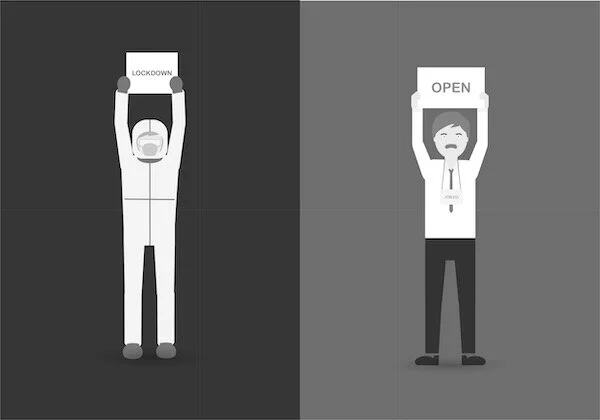Unlocking the Lockdown – Health vs. Wealth or Health vs. Health
Note: For those of you who follow me from other parts of the world, this blog is focused on activities and decisions being made in the US, though much of this information may apply to your country as well.
Decision: When And How To Open Up The Economy, Not Whether We Should
TL;DR
What do we know? The Center for Infectious Disease Research and Policy report released a few days ago warns that, without a highly effective vaccine, Americans need to develop “herd immunity” to COVID-19 over the next 18 months, which means that 60%-70% of the population has to be infected to some degree.
We need to “flatten” the curve, spreading out the cases of COVID-19 over a longer period of time so the healthcare system is not overwhelmed.
Why is opening the economy so important? As of December 2019, more than half of the US population didn’t have enough cash on hand to survive for three months.
“The economy” is people earning enough to survive.
What is the cost of not opening the economy? The mental health of the working class. Increased chances of alcoholism, drug use, crime, and suicide.
What are the risks of opening the economy? COVID-19 is very risky for people over 74, and especially for those older than 85. Let’s protect them, but realize they aren’t part of the work force.
For most age groups, the chance of dying by suicide is higher than the chance of dying by Cov-19.
When do we act? We can’t wait to see what happens in the next three months. It will be too late.
What is the solution? It’s a balancing act, but it isn’t like flipping a light switch on or off. Opening the economy should be done gradually–more like using a dimmer switch.
For people under 50 with no pre-existing conditions, the mortality rate from COVID-19 is very low. This group is the bulk of the workforce. Gradually open the economy so they can afford to live and prevent widespread desperation leading to mental health issues, drug and alcohol abuse, crime, and suicide.
“The dignity of the individual will flourish when the decisions concerning his life are in his own hands; when he has the means to seek self-improvement.”
If you want to make an evidence-based decision, analyze the data and think. Get rid of the emotions.
As behavioral psychologists and pollsters know, how you ask a question can heavily influence the response you get. This cognitive “trick” is called “framing” and, done well, can manipulate the person being questioned into responding the way you want–even the most highly-educated people, even people in positions of great power.
In today’s debate about when and how to open up the economy amidst the COVID-19 pandemic, “Health vs. Wealth” has emerged as the overused phrase meant to capture the dilemma at hand.
If we look at the data-driven hard science rather than the emotionally-charged, incite-inducing propaganda, the “Health vs. Health” argument makes a lot more sense.
Actual Facts
According to the CDC, the second leading cause of death for people under 34 years of age is suicide. The death rate from COVID-19 for that group is about .01-.02%
The 4th leading cause of death for people 35-54 is also suicide. The death rate from COVID-19 for this group is way under 1%.
To make a decision about when and how to “open the economy,” we need to access realistic health risks. We need to compare the risk of death by COVID-19 within specific groups and death by something else, like suicide, inside those same groups.
While we would love to reduce mortality rates from COVID-19 to near zero and open the economy full blast tomorrow, it’s not realistic. We need to achieve the proper balance, do it gradually and thoughtfully, and we need to do it very soon.
The idea of gradually opening the economy is rather clear at this point, and it isn’t an on-off switch. It should be more like a dimmer switch, gradually opening the economy more and more as it is safe to do so–and with consideration for the real health risks.
What is the economy?
The economy isn’t the stock market. The economy is people working at jobs and earning a living, producing and consuming goods and services.
We now have the highest unemployment since the Great Depression of 1929.
The people most adversely impacted by closing businesses are not the large corporations but smaller businesses and working-class people.
If you can’t work, you apply for unemployment and other benefits, but those government subsidies do not pay the same as a full-time job and will only cover you for a certain period of time.
Health vs. Health
As the German Minister of Health recently stated, “It’s not the health of people versus the economy because they are very much interlinked…You need a strong economy to have a well-equipped health system. Unemployment and recessions are harmful for the mental and physical health of people too.”
It is basic that when you run out of money to pay for food, rent, or mortgages, it creates high levels of stress. Stress on its own is extremely unhealthy, as is increased alcohol and drug use caused by stress.
According to a recent Pew Research finding (as reported in the New York Times on April 26, 2020), less than half of all Americans had enough money to cover three months of expenses.
Facing personal financial disaster puts people under tremendous stress. If financial disaster becomes widespread, it is obvious that suicide rates, alcohol and drug abuse, and crime will not go down. When faced with desperation and unable to buy food to survive, even mentally healthy people who would otherwise never break the law will do anything to survive.
We need to open the economy so people can get back to work, pay their bills, and relieve the increasing stress. What is left to determine is how best to do that.
Here’s where the dimmer switch comes in.
Data-driven Decisions
We need some sort of social distancing to continue, but if you are under the age of 50 without a pre-existing condition, your risk of death is low.
People over the age of 74 are most at risk, especially those over age 85.
These people need to continue to be isolated, most critically where there are groups of them, such as nursing homes and other senior living facilities.
But almost no one in those age brackets is in the work force.
The only remaining age bracket with any substantial risk is between age 65 and 74, and while some of them work, most don’t.
The Solution:
-Keep strict procedures in place to protect those most at risk, like seniors.
-Start allowing businesses to open in stages. Different industries need different rules. It won’t be one size fits all, and it needs to be coordinated.
-Recognize that the risks involve both physical wellbeing and mental health. Give people the data that the CDC is providing to empower them to make their own decisions based on their needs and risk tolerance.



